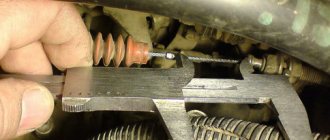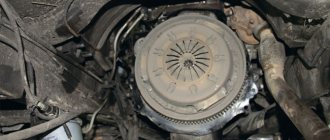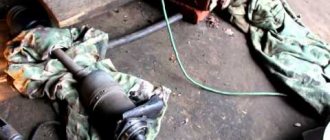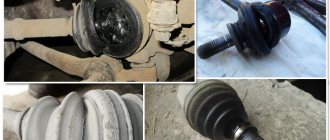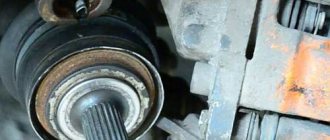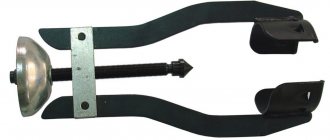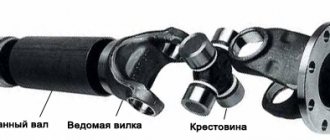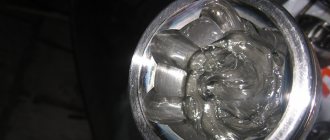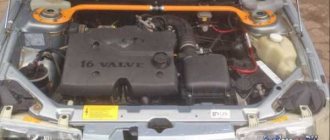This term has other meanings, see Hinge.
Constant velocity joint The principle of operation of a ball CV joint of the "Rtseppa" type
Constant-velocity joint
(CV joint, slang -
grenade
) provides torque transmission at angles of rotation from 1 to 70 degrees relative to the axis. CV joints are sometimes called “homokinetic joints” (from ancient Greek ὁμός - “equal, identical” and κίνησις - “movement”, “speed”).
It is used in steering wheel drive systems of passenger cars with independent suspension and, less commonly, rear wheels and in front wheel drives of SUVs, sometimes on rail rolling stock.
The first attempts to implement front-wheel drive were carried out using conventional universal joints. However, if the wheel moves in a vertical plane and is also rotary, the outer joint of the axle shaft has to work in extremely difficult conditions - with angles of 30-35°. And already at angles greater than 10-12°, power losses in the cardan transmission sharply increase, in addition, rotation is transmitted unevenly, wear on the joint increases, tires wear out quickly, and the gears and transmission shafts begin to work with high overloads. Therefore, a special hinge was required - a constant velocity joint - devoid of such disadvantages, transmitting rotation evenly regardless of the angle between the connected shafts.
History of the creation of the CV joint
Since there are several designs of a constant velocity joint, it is quite difficult to determine which one arose first. It is known that the ball-type CV joint, the most common these days, first appeared in the twenties of the last century. The cam CV joint was developed by a French inventor named Grégoire. In the early twenties, he patented the invention under the name “Tracta”. Another type - a twin universal joint - was used mainly in US-made cars of the twenties, such as the Cord L29, as well as in the transmission of French Panhard-Levassor cars of the 50s and 60s. Nowadays, it is used in vehicles that do not develop high speed, for example, on tractors.
Basic faults
After we have examined the possible designs of joints with equal angular velocities, we can summarize that in modern passenger cars only ball and tripoid joints are used.
In general, structurally, CV joints are very reliable and should easily last 100,000, or even 200,000 km. But in practice, there is an earlier failure of the unit and the system, as for example I had in my previous car, the inner right CV joint died at 75 thousand (more details at the end of the article). As a theoretically trained person (I studied for 5 and a half years to become an engineer in the specialty “Automotive Engineering” and worked in this field for several years), as well as having encountered a hinge failure on my car, I can name the main causes of failures.
All loaded hinge elements are made of high-strength materials, the parts are manufactured with high precision and the new hinge has no backlash or gaps. Over time, the rubbing parts (rollers, balls, housing, separator) wear out and gaps appear.
It is the resulting gaps that are the cause of the two main malfunctions of CV joints:
- Crunch
- Vibration when accelerating a car
Let's dig even deeper, and what can lead to the premature appearance of gaps?
The hinge must be hermetically protected from road dust and dirt; this function is performed by a boot, which is made of rubber and is placed on the outside of the CV joint.
During operation, cracks and even tears form on the boot; accordingly, its tightness is lost, and dust that gets into the hinge acts as an abrasive and quickly gets to the rubbing elements, speeds up their wear and increases the gaps.
The most interesting thing is that such an absurd “death” of the CV joint can only be prevented by constant visual monitoring of the condition of the anthers (at least once every 5–7 thousand km). How many of you do this? So I didn’t do it, and I paid for it.
I would like to give advice to those who discovered a break in the boot in time and are planning to replace it. The boot must cover the CV joint 100% and be sealed. Original products are very expensive and there is a temptation to remove the boot and choose the most suitable analogue. Don’t do this, don’t repeat my mistakes, saving 1000 rubles may later result in the purchase of a new CV joint, which can cost from 5 to 15 thousand rubles.
Also pay attention to the lubricant; tripoid type bearings are especially picky about it, since they contain needle bearings. Therefore, lubricants that have solid lubricating additives and also contain molybdenum disulfide are unacceptable for use in the internal CV joint, but for external CV joints, lubricants with molybdenum disulfide are acceptable and, what’s more, even recommended. As you understand, another reason for the premature “death” of the CV joint is improper lubrication.
Crunching is also a sure sign of CV joint failure; at first it appears only on inverted wheels, then it makes itself felt at small angles and even on straight wheels. The cause of the crunching may be the entry of dirt due to a rupture of the boot, and in some cases the cause may be an unsuccessful collision with a curb or falling into a hole at a decent speed.
Purpose of the CV joint
The constant velocity joint is used in the independent suspension of the front steered wheels, provided that they are also drive wheels. The CV joint is a composite part, and in addition to rotation, it provides a rotation angle of up to 70 degrees, which allows it to be used in the design of the drive axle.
The similarity of the CV joint to a hand grenade provided it with a corresponding nickname, and not only in Russian
Less common in rear-wheel drive and all-wheel drive vehicles, and only if an independent suspension is also used at the rear. In this case, each of the rear wheels has, albeit limited, but not synchronized with the other wheel, the ability to move in horizontal and vertical planes, which makes it impossible to use drive shafts traditional for the rear drive axle.
If the angle between the joints is small, universal joints of unequal angular velocities can easily cope with the transmission of torque. As these angles increase, the shafts begin to rotate too unevenly, which makes transmission operation problematic and leads to loss of power. To solve such problems, there is a CV joint.
The design and principle of operation of the CV joint
Depending on the type (ball, tripod, cam or twin cardan), the design of the CV joint may be different. However, their role in the transmission design is the same: the CV joint is part of the drive shaft. One side of the shaft is inserted into the wheel bearing, and the other into the differential. Constant velocity joints transfer rotational energy from the engine to the drive wheels through the hub bearings.
The two main components of a CV joint are the body and the race located inside it. Both of these elements have grooves in which balls are located. They rigidly connect both parts, which have a spherical shape, and transmit rotation.
For outer and inner CV joints, different types of joints are used: the outer end of the drive shaft is equipped with ball joints, and the inner end with tripod joints
The range of the working angle of the outer CV joint is wider than that of the inner one, since when the steered wheel is turned, the angle of rotation of the outer CV joint can reach up to 50 degrees. The working angle of the inner CV joint does not exceed 20 degrees. Therefore, different types of joints are used for external and internal CV joints: the outer end of the drive shaft is equipped with ball joints, and the inner end with tripod joints.
The design of the outer CV joint includes a cage mounted on the shaft with six grooves located along the radius. The assembly body has the same number of radial grooves. They contain balls that transmit torque. This transmission occurs from the shaft to the CV joint housing and further to the wheel hub.
The CV joint design allows bending, but not axial movement. Internal CV joints, designed for both bending and axial movement, have a slightly different design.
Internal constant velocity joints also differ from each other. This depends on the car model they are installed on. For example, in VAZ internal CV joints the body grooves are straight, not radial.
And in the internal CV joint of the Tavria, the rollers are mounted on three spikes of the cross, which rotate on needle bearings. They are placed in the internal longitudinal grooves of the CV joint housing. Thus, the joint is provided with both bending and axial movement.
The CV boot is held in place by two clamps. They are sold complete with any new CV joint.
Since the CV joint is located in a problem area where there is a lot of dirt and dust, it is equipped with sealed protection. This role is played by the boot - a corrugated rubber lining secured to the CV joint body with clamps.
Despite the variety of design solutions for CV joints, the principle of their operation remains unchanged - the contact points that transmit circumferential forces must necessarily be located in a bisector cavity passing through the bisector of the angle formed by the shafts.
Cardan joint type GKN
Universal six-ball universal joint GKN
: 1 — retaining ring of the internal hinge housing; 2 — protective ring of the internal hinge; 3 — internal hinge body; 4 — shaft stop; 5 - retaining ring; 6 — clip; 7 - ball; 8 - thrust ring; 9 - separator; 10 - outer clamp; 11 — lock of the internal hinge; 12 — protective cover; 13 — internal clamp; 14 — wheel drive shaft; 15 — protective ring of the outer hinge; 16 — outer hinge housing
Axial movement is ensured by the movement of the balls along the longitudinal grooves of the housing, while the required amount of movement determines the length of the working surface, which affects the dimensions of the hinge. The maximum permissible shaft inclination angle in this design is limited to 20°. During axial movements, the balls do not roll, but slide, which reduces the efficiency of the hinge.
Advantages and disadvantages of CV joints
The obvious advantages of the CV joint include the fact that when transmitting power using this joint, there is almost no loss of power compared to other similar mechanisms. Other advantages are its light weight, relative reliability and ease of replacement in case of breakdown.
The disadvantages of CV joints include the presence of a boot in the design, which is also a container for lubricant. The CV joint is located in a place where it is almost impossible to prevent its contact with foreign objects. The boot can be torn, for example, when driving on a rut that is too deep, when driving over an obstacle, etc. As a rule, the car owner finds out about this only when dirt has already entered the boot through a crack in the boot, causing intense wear. If you are sure that this happened recently, you can remove the CV joint, wash it, replace the boot and fill it with new grease. If the trouble happened a considerable time ago, the CV joint will definitely fail ahead of time.
Weiss universal joint
Weiss type joint with dividing grooves
: 1, 5 — shafts; 2, 4 — fists; 3 - balls; 6 — centering ball; 7, 8 — fixing pins
The disadvantages of double joints and cam-type joints were the impetus for the search for new solutions, and in 1923 the German inventor Karl Weiss patented a ball joint with dividing grooves ( Weis type
). The peculiarity of this hinge is that when the car moves forward, the movement is transmitted by one pair of balls, and in reverse - by another pair. Transmission of forces by only two balls at point contact leads to large contact stresses. Therefore, it is usually installed on vehicles with axle loads not exceeding 30 kN. During the Second World War, similar production hinges were installed on cars such as Willys, Studebaker, and Dodge. In domestic practice, they are used on UAZ and GAZ-66 vehicles. Weiss-type joints are technologically advanced and cheap to manufacture; they allow an angle between the shafts to be obtained up to 32°. But the service life, due to high contact stresses, usually does not exceed 30 thousand km.
